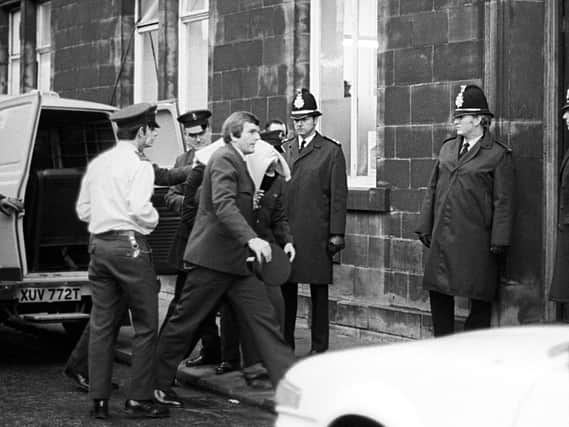Tragedy of Peter Sutcliffe's victims made more heart-rending by police incompetence - Andrew Vine


They are frozen in time in the pictures the police issued as they appealed for information, 13 women, their lives taken with bestial savagery.
The tragedy of their murders by Peter Sutcliffe is undimmed by the almost four decades that have passed since his conviction and imprisonment, and made more heart-rending by the incompetence of the police who failed to catch him.
Advertisement
Hide AdAdvertisement
Hide AdNine times they questioned him. Nine times. They had uncannily accurate descriptions and photofit images of him, even a letter identifying Sutcliffe as the killer.
Yet in the end, he was caught by chance by two policemen on routine patrol in Sheffield’s red-light district.I shall never forget the wave of relief that swept across Yorkshire when the arrest was announced in the January of 1981. It felt like a dark shadow that had lain across our county for years suddenly vanished.
The air of menace that had settled over our towns and cities is hard to overstate. Anybody who didn’t live through it might find it difficult to believe, but there was a sense of real fear.Somewhere in our midst was a murderer who killed with impunity, wherever and whenever he chose – in a park in Leeds or Halifax, on waste land in Huddersfield, in a busy student area.
And his presence reached into every life. Women dared not go out alone after dark, following police advice.
Advertisement
Hide AdAdvertisement
Hide AdOn the street where I lived, all our mothers never even walked to the shops 500 yards away on their own, especially in winter when it got dark early. They always went there and back in groups.
The Yorkshire Ripper’s presence was all-pervasive. On my way to school in the late 70s, I passed billboards appealing for information. At the end of the day, female staff were walked to their cars by male colleagues, and locked the doors once inside.
At the central bus station in Leeds, I heard the tape of the soft Wearside voice taunting detectives being played over the public-address system as passengers stood transfixed, listening to his words, and then the appeal to contact the police if they recognised him.
Although invisible, the Ripper seemed to be everywhere. No street felt safe, or any night-time setting. It dragged on and on for years, and the longer it did the more menacing his presence became.
Advertisement
Hide AdAdvertisement
Hide AdWe all knew the names of the victims and could almost recite the order in which they had been murdered, so seared into the collective consciousness were they.
What made it worse was the dismal ineptitude of the police. At each new horror reported in The Yorkshire Post and Yorkshire Evening Post that came through the letterbox morning and afternoon, the questions asked in our house were being asked in every other home.
What are they playing at? Why can’t they catch him? How much longer must this go on?
The police had no answers. On the televised press conferences, they appeared out of their depth. And then maybe the biggest blunder of all – the so-called Ripper Tape.They swallowed the grimmest hoax in British criminal history hook, line and sinker. Despite Sutcliffe’s surviving victims telling detectives their attacker spoke with a Yorkshire accent, the focus of the entire investigation switched to the North East.
Advertisement
Hide AdAdvertisement
Hide AdWhen it turned out that the Ripper was a Bradford lorry driver, and not the man on the tape, the relief at Sutcliffe being caught turned to anger.
The questions asked in homes all over Yorkshire had finally been answered. Incompetence on a staggering scale had allowed him to get away with murder.
Mistakes had been compounded by a stubborn refusal to deviate from fixed ideas.
The public quickly realised what had happened – the investigation had come nowhere near catching Sutcliffe. It was sheer luck that he had been stopped. Every newspaper in the land carried a photograph of the senior officers in the investigation laughing delightedly at a press conference to announce that an arrest had been made.
Advertisement
Hide AdAdvertisement
Hide AdI remember people looking at that and asking each other what there was to laugh about. Thirteen women were dead.
It must be of scant consolation to those who loved each of them that the debacle of the Yorkshire Ripper enquiry led to a shake-up of British policing to ensure nothing like it could ever happen again.
The introduction of computerised systems for collating information, better training for senior officers and greater cross-border co-operation between forces were among the measures introduced.
Though he is dead, Peter Sutcliffe will continue to nag at Yorkshire’s memories of the 1970s and the start of the 1980s, forever casting a shadow across them.
Advertisement
Hide AdAdvertisement
Hide AdAnd he takes to the grave the answer to another question that everyone who lived through those years asked themselves. How many more victims were there?
--------------------
Support The Yorkshire Post and become a subscriber today. Your subscription will help us to continue to bring quality news to the people of Yorkshire. In return, you'll see fewer ads on site, get free access to our app and receive exclusive members-only offers. Click here to subscribe.